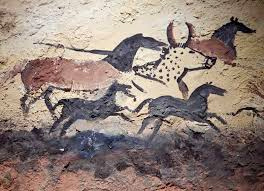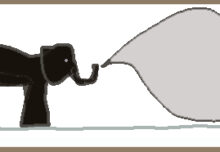CAVE PAINTING
Last year I wrote an article about the cave paintings in Lasceaux France. That blog post was mostly about the pigments used. And something about the state of the Lasceaux cave which has a virus problem. [link] The Lasceaux cave system is between 10,000 and 20,000 years old.

cave art
Much older cave paintings and other evidence have dated cave art in Maros, South Sulawesi, Indonesia, to 40,000 years.
Until recently it was thought that the oldest cave painting known was a 40,800-year-old red disk from El Castillo, in northern Spain.
Today the news is about ‘humanity’s oldest known 73000 year old drawing’ found in South Africa. [BBC 13Sept18]
So we got around in those days.
ABSTRACT ART
The age of cave art can now be estimated through analysis of small radioactive traces of uraniam isotopes present in the crust that had accumulated on top of the paintings.
Gorhams cave on Gibralter is an interesting example. Scratches on the floor, found under deposits that have been dated, look as though they were created 40,000 years ago.
Those scratches have been described as ‘abstract art’ by Joaquín Rodríguez-Vidal of the University of Huelva, for whom it is “the first directly demonstrable example of an abstract work, carried out consistently and with care and requiring prolonged and concentrated work, that has been produced in a cave.”
WHO DID IT?
The Gorham cave abstractions have been attributed to Neanderthals but it is still possible that Homo Sapiens might have been around at that time. So the definite attribution of the scratches to Neanderthals is disputed.
However, in two new studies, in online Science magazine, researchers lay out the case that some works of art predate the arrival of modern Homo sapiens to Europe, which means someone else must have created them.
In three caves scattered across Spain, researchers found over a dozen examples of wall paintings that are more than 65,000 years old. At Cueva de los Aviones, a cave in southeastern Spain, researchers also found perforated seashell beads and pigments that are at least 115,000 years old.
“The Aviones finds are the oldest such objects of personal ornamentation known to this day anywhere in the world,” says study co-author João Zilhão, a University of Barcelona archaeologist. “They predate by 20 to 40 thousand years anything remotely similar known from the African continent. And they were made by Neanderthals. Do I need to say more?”
THEM OR US?
In light of the two lineages’ identical knack for art, the researchers even call into question whether Neanderthals were truly a distinct species, or instead an isolated European subgroup of modern humans.
“The only species that were around at that time were Neanderthals,” Alistair Pike, an archaeologist from the University of Southampton in England. “So, therefore, the paintings must’ve been made by them.”
Knowing that the Neanderthals made art upends the conventional view of Homo Sapiens’s closest relative. Long believed to have been a more primitive, less intelligent species than modern humans, Neanderthals may have been more like our direct ancestors than previously imagined.
Like us, they independently began making art—which also suggests they may have even had a spoken language. In their findings, the research team noted that it now appears that “Neanderthals and early modern humans were cognitively indistinguishable.” This contradicts a recently published theory that our capacity for art gave us an advantage over the Neanderthals, who went extinct about 40,000 years ago, shortly after Homo sapiens arrived in Europe.
“I think we should accept them as part of us,” Pike said. “They are part of our lineage, they are human, they’re just a different human population.”
We know that something like 2% of our dna is Neanderthal so we must have interbred at some time. And new art research might even mean that Neanderthal man and Homo Sapiens were not actually different species after all.
“The conclusion has to be that Neanderthals were cognitively indistinguishable [from Homo sapiens], and the Neanderthal versus sapiens dichotomy is therefore invalid,” argues Zilhão. “Neanderthals were Homo sapiens, too.”




